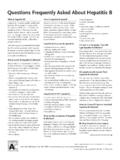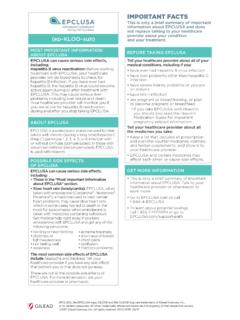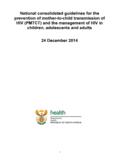Transcription of Recommendations for breastfeeding during …
1 S1811. , University of California, Los Angeles, USA. Full professor,Department of Pediatrics, School of Medicine, Universidade Federal deMinas Gerais (UFMG). Advisor of the Graduate Program in Child andAdolescent Health, UFMG, Belo Horizonte, MG, MSc. Professor, School of Medicine, Universidade Federal de MinasGerais (UFMG), Belo Horizonte, MG, , School of Medicine, USP, Ribeir o Preto. Professor, School ofMedicine, Universidade Federal de Minas Gerais (UFMG). Advisor of theGraduate Program in Child and Adolescent, UFMG, Belo Horizonte, MG, citation: Lamounier JA, Moulin ZS, Xavier for breastfeeding during maternal infections. J Pediatr(Rio J). 2004;80(5 Suppl) : To make a literature review on breastfeeding and maternal infectious diseases in order to contribute withknowledge and information that can aid the pediatrician to decide upon allowing infected mothers to breastfeed theirbabies or of data: Lilacs and MEDLINE databases were searched for books, technical rules and articles on the issueof breastfeeding and infected of the findings: Infected lactating mothers can transmit pathogenic agents to their infants.
2 Althoughbreastfeeding protects the child it can also be a dangerous source of infection. Maternal diseases caused by bacteria,virus, fungi and parasites may sometimes be transmitted via human milk. The literature points out that mothersinfected with HIV and T-lymphotropic human viruses (type I) should not breastfeed. With other diseases a carefulapproach should be made, but, in general, breastfeeding is : The mother who is exposed to infectious diseases may transmit pathogenic agents through thehuman milk, attention should also be made to milk from milk banks. The healthcare provider must take his/herdecision upon suspending breastfeeding - or not, what can be distressful, once he/she has a fundamental role inpromoting and stimulating Pediatr (Rio J). 2004;80(5 Suppl):S181-S188: Human milk and infection, mother s infectious illnesses, maternalbreast-feeding and for breastfeedingduring maternal infectionsJoel A. Lamounier,1 Zeina S. Moulin,2 C sar C. Xavier30021-7557/04/80-05-Suppl/S181 Jornal de PediatriaCopyright 2004 by Sociedade Brasileira de PediatriaIntroductionHuman milk, in addition to its nutritional components,contains numerous cells, membranes and molecules whosefunction is to protect newborn infants.
3 In lactating women,the enteromammary or bronchomammary immune systemis activated when pathogens (bacteria) come in contact withthe mucous membranes of the intestine or respiratory tractand are phagocytosed by macrophages. This stimulates Tlymphocytes, causing the differentiation of immunoglobulinA (IgA)-producing B lymphocytes. Lymphocytes migrate tothe mammary gland and, mediated by cytokines, turn intoplasma cells that produce a glycoprotein, which binds toIgA, and eventually turns into secretory immunoglobulin A(sIgA). This is an important and specific protective functionof human milk in , given its benefits to mother and infant,is considered to be the best form of nutrition for , maternal and infant diseases may hinderbreastfeeding. Under these circumstances, the healthprofessional should be skilled, have technical knowledgeand adopt a favorable attitude so as to properly assess theviability of breastfeeding . When the nursing motherpresents with the symptoms of a disease, she has alreadyexposed her infant to the pathogen and the usualrecommendation is that breastfeeding should If the mother discontinues breastfeedingafter symptom onset, infant protection against diseasesis decreased, and the chances of the infant falling ill areincreased, since he/she is not provided with specificantibodies and other protective factors from human ARTICLES182 Jornal de Pediatria - Vol.
4 80, (suppl), 2004No recommendation to discontinue breastfeeding , evenif temporarily, exists in cases of mothers with urinary tractinfection, bacterial infection of the abdominal wall,episiorrhaphy, mastitis or any other disease in which thenursing mother s physical conditions and general state ofhealth are not so human milk contains antibodies, mononuclearcells and other protective factors, it may be a possiblesource of infection for the infant in some maternal ,7 The mononuclear cells in human milk, albeit providingprotection, may transfer infectious particles from the motherto the infant. Thus, when health professionals attend to anursing mother with active viral infection or another infectiousdisease, they may become uncomfortable about whetherthey should discontinue or not breastfeeding , as their roleis to promote and encourage infectious diseases may impede breastfeeding ,either on a temporary or permanent basis, due to maternalphysical conditions such as severe cardiac, renal, andhepatic diseases, psychosis and severe the present review, we discuss breastfeedingmanagement in the presence of common maternal diseasescaused by bacteria, viruses, parasites and infectionsIn several maternal viral diseases, such as hepatitis,herpes, measles, mumps and rubella, among others, thevirus may be excreted into human milk.
5 However, exceptfor infections caused by retroviruses, humanimmunodeficiency virus (HIV-1), human T-lymphotropicvirus type I (HTLV I) and human T-lymphotropic virustype II (HTLV II), transmission via human milk has littleepidemiological relevance. In most maternal viraldiseases, other sources of contamination of newbornsshould be considered before ascribing the cause tobreastfeeding only. The risk of transmission may beenhanced in cases of acute infection at delivery, as themilk may contain a high concentration of viral particlesand low titers of protective antibodies able to neutralizethe infectious agent. Therefore, in general, there is noformal contraindication for breastfeeding in most cases ofviral diseases, except for diseases caused by transmission of RNA retrovirus, including HIV-1,11,12 HTLV I and HTLV II13 has already beendemonstrated. HIV-2 can also be transmitted from motherto infant, but the role of breastfeeding in the transmissionvia human milk has not been clearly established yet.
6 TheEpstein-Barr virus and herpesvirus 6 can be found inhuman milk, but so far, reports on breastfed infantsinfected by these viruses have been few and far some extent, the fact that breastmilk is not much moreinfectious is surprising, especially due to the daily volumeingested by exclusively breastfed infants. Supposedly,there may be other protective factors than those 1 summarizes the most important infections,with possible transmission of the virus to the infant viabreastmilk, and the corresponding infectionHIV is excreted freely or into cells in the milk ofinfected women, who may or may not present withsymptoms of the disease. Approximately 65% of verticalHIV transmission occurs during labor and during delivery;the remaining 35% occurs in utero, mainly within the lastweeks of gestation and via breastfeeding . The viral loadin breastmilk is an important determinant for the risk ofTable 1 -Maternal viral infections and the corresponding breastfeeding managementType of virusRecommendationCytomegalovirusBreast feedingHepatitis A*BreastfeedingHepatitis BBreastfeedingHepatitis C*BreastfeedingRubellaBreastfeedingMumps BreastfeedingSimple herpesBreastfeeding, except if there are lesions on the breastsVaricellaBreastfeeding, except if the infection was acquired between 5 days beforethe delivery and 3 days after the deliveryMeaslesTemporary interruption of breastfeedingHTLV INo breastfeedingHIVNo breastfeeding * See comments in the during maternal infections Lamounier JA, et aliiJornal de Pediatria - Vol.
7 80, (Suppl), 2004 In newborns, the virus penetrates thenasopharyngeal and gastrointestinal mucosae. Duringbreastfeeding, viral transmission may occur at any stage,but it seems to occur more often within the first weeks andespecially in most recent maternal infections. The viralload in colostrum is significantly higher than in maturemilk. Mixed breastfeeding seems to pose more risks thanexclusive breastfeeding , due to the major injury to thegastrointestinal mucosa resulting from artificial feeding,which favors the penetration of the The additionalrisk of transmission of the virus via human milk rangesfrom 5 to 20%.18 Contamination via breastmilk in womenwho acquired the infection after the postnatal period wasdetected in 29% (15-53%) of ,16,18 The presenceof HIV-infected cells in breastmilk for over 15 days afterdelivery is an important predictive factor for infection inthe can infect mammary epithelial cells beforedelivery, and can be found free or infecting monocytes inmilk, which account for 50% of cells found in cells can potentially carry the virus from the maternalbloodstream or from lymphoid tissues to the infant s types of HIV use chymosin receptors to infectmacrophages.
8 However, more studies are necessary toaccurately define the role of human milk cells in use of antiretroviral therapy during pregnancy anddelivery and its maintenance in newborns results in adecrease in vertical HIV transmission for up to six monthsafter childbirth,22 even if breastfeeding is , HIV infection is one of the few situations inwhich the contraindication for breastfeeding is a commonagreement. In Brazil, The Ministry of Health23 recommendsthat HIV-infected mothers should not breastfeed. On theother hand, the World Health Organization and UNICEF recommend that, in poor countries, where diseases such asdiarrhea, pneumonia and malnutrition substantiallycontribute to high rates of infant morbidity and mortality,the benefits of breastfeeding should be considered in relationto the risk of HIV transmission. In these cases, and if it isnot possible to provide appropriate artificial feeding, breastfeeding should be maintained, given its benefits toinfants who live in precarious ,24,25 Womenwho receive combined antiretroviral therapy have lowerrates of viral Preliminary informationobtained from a study conducted in South Africa considersthat it is possible to reduce or prevent the risk of postnataltransmission of HIV if the infant receives human milk for ashort period of The idea is to maintain breastfeedingfor four to six months.
9 However, the efficacy and safety ofsuch practice has not been demonstrated yet, and studiesstill have been alternative is to reduce or eliminate HIV fromhuman milk. Infected cells can be removed from milk, butviral particles are difficult to eliminate. The inactivation ofHIV in breastmilk through pasteurization ( C for 30minutes, followed by rapid cooling) allows infants tocontinue receiving breastmilk without increasing thepostnatal risk of ,27 HTLV infectionHTLV belongs to the retrovirus family, the same ofHIV. They are human T1 and T2 lymphotropic virusescalled HTLV I and HTLV II. Type I causes a rare type ofleukemia, myelitis and eye infection that may result inblindness. HTLV II is not associated with disease. Theycan be transmitted via blood, infected needles, sexualintercourse and from mother to infant by means ofbreastfeeding. The principal mode of transmission isvertical, but the predominant one is via HTLV affects a small portion of the population,with possible late development of diseases in only 1 to 4%of infected individuals, its occurrence has increased in SouthAmerica, especially because of the lack of health the disorders caused by these retroviruses are severeand cannot be treated or controlled with efficient therapyand vaccine, contraindication for breastfeeding in infectedwomen is a major way of reducing their vertical Japan, freezing the milk of HTLV I-positive mothersat -20 C has been used as a way to inactivate the , the Center for Disease Control and Prevention(CDC) establishes that every HTLV I-infected mother shouldbe advised not to breastfeed, and does not have an opinionon the freezing of human milk in this situation.
10 CDCconsiders the current data on HTLV I transmission via frozenand thawed breastmilk to be amount of HTLV I-infected cells in peripheral bloodis very small compared to the number of infected T cells inbreastmilk, which explains the high risk of viral transmissionvia human milk. Some risk factors have been considered inthe transmission of HTLV I and II via human milk: breastfeeding for over three months, advanced maternalage, antigen levels in maternal blood and high titers of HTLVI antibodies in the nursing ,17 However, Van Dykeet report that the transmission of HTLV II from motherto infant may occur regardless of the type of feeding theinfant receives in similar rates to those of HTLV I, thusshowing that the virus can be transmitted to the infant in theabsence of A, B and CHepatitis A, B and C viruses can be transmitted to theinfant during pregnancy, delivery or postnatal transmitted by the oral-fecal route, as in hepatitisA, have a higher chance of being transmitted to the infantat hepatitis A virus can be excreted into human milkin the acute phase of the disease.














